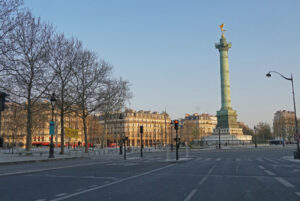Preservation in Paris
While passing through the bustling transportation hubs in Paris, it is easy to get caught up in the blur of modern life. Trains rush past, commuters move in every direction and advertisements glow all around you.
However, if you take a minute to slow down on the Line 5 platform, you’ll notice something interesting: the stone foundations of the Bastille fortress, jutting out from the tunnel’s wall. This section of chiseled stone is an unexpected reminder of Paris’s lengthy past. Beneath the surface of the modern city lies a rich, often hidden history.
This small section of wall serves as a perfect example of how cities like Paris face the challenge of modernizing without erasing the past.
History
The Bastille was originally built in the late 1300s as a fortress to defend the eastern part of Paris. Later on, it was used as a prison by the monarchy to hold political dissidents and others without trial.

By the late 1700s, it no longer held many prisoners but had become a powerful symbol of royal tyranny and oppression. On July 14, 1789, revolutionaries stormed the Bastille, marking the start of the French Revolution.
Shortly afterward, the fortress was dismantled stone by stone and its fall became a symbol of freedom and revolution. Today, the French celebrate Bastille Day every year to honor that moment.
Modern Day
The spot where the Bastille once stood is now a busy traffic circle. A large pillar, known as the July Column, stands in the middle and commemorates The July Revolution of 1830 rather than the fall of the Bastille. However, engineers found a way to honor the site’s legacy more by integrating a plaque along with the remains of the fallen fortress into the metro system.

What’s even more impressive is that this kind of preservation happens all over Paris, not just for 18th-century landmarks, but for ruins that are thousands of years old.
For example, beneath Notre-Dame, the Crypte Archéologique protects remnants of ancient Roman streets and sewers. Also, near the Cluny Museum, the partially preserved Thermes de Cluny bathhouse dates back to the 3rd century.
Civil engineers and city planners in Paris aren’t just preserving the recent past, they’re finding ways to balance infrastructural developments and innovation while building on thousands of years of history.
Across the Ocean
In comparison, cities in the United States often don’t face the same challenge, not because we don’t care about preservation, but because our cities are younger.
For example, Boston, Philadelphia, and Williamsburg have had lots of work done to protect buildings from the 1700s and 1800s. Even across the Midwest and South, old train depots, mills, and Civil War sites are maintained by historical societies and redevelopment efforts. Out west there are indigenous locations, some even older than colonial settlements, that are being preserved as important pieces of American heritage.
That being said, American infrastructure doesn’t sit on top of Roman or medieval ruins. That gives planners much more freedom to expand and update without the complexity of working around ancient stone foundations.
Still, there is a lot we can learn from the European approach, like how modernization doesn’t have to erase history. In fact, it can preserve it, and even showcase it to the public.
Written by Brendan G
References:
RATP. (n.d.). Bastille station. RATP. https://www.ratp.fr/en/discover/behind-the-scenes/daily-life/bastille-station
Encyclopaedia Britannica. (n.d.). Bastille. https://www.britannica.com/topic/Bastille
